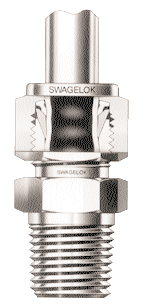
FITTINGS
Materials
Brass is cheaper than stainless steel and safer in high-O2 environments (see
Oxyhacker's Companion). However, most brass fittings and valves are not rated
above 3000 PSI. The next best choice is stainless steel (SS). I
oxygen-cleaned every fitting used in this project, without exception.
Connection types
SS fittings are common, but very expensive to buy on the retail market depending
on the configuration. 1/4" NPT (National Pipe Taper) and 1/4"
outside diameter (OD) tube
fittings are the most common (and almost the cheapest) size of SS fittings to
buy. This mainly influenced my decision to use these as much as possible. Most 1/4" tube
or NPT fittings are rated to at least 5,000PSI, so they suit most fill-station
applications. . There has to be some forethought on how to plumb the
genders together, as couplings and nipples can subtly increase the cost of using
one type of fitting over another. Use of adapters adds potential leakage
points into the lines.
1/4" SS tubing can handle plenty of pressure, depending on
how thick its walls are. 1/4" tube fittings are sometimes referred to as
"instrumentation fittings." The other reasonable alternative to
using tubing was high-pressure whip
hose, which costs a bit more, is subject to wear, and not recommended for
oxygen exposure above 3000 PSI. Any non-tube fittings I chose were common, NPT
threaded. There's even brass tubing available for pressures <4000 PSI, but
may require different fastening methods and fitting considerations.
Brands
There are many companies manufacturing 1/4 tube fittings. All 1/4"
tube fittings can work with virtually any 1/4" OD tubing. The nuts and
ferrules are usually always interchangeable among a core group of different
manufacturers that have designed and tested, their fittings with each
others'. You may see a list of compatible manufacturer's names listed in their PDF
technical documents sometimes; SwageLok, Duolok, Cajon, Valu-Lok, Apollo, Letlok,
Gyrolok, Unilok, Dk-lok, A-Lok. They're all about the same, even a batch of
Israeli-made Ham-Let fittings that I found and bought in a pinch. For a look at
what's available,
here's SwageLok's PDF on their entire line, along with
some great application information. Most of the other manufacturers have
similar documents one their sites as well.
Tube-ferrule types

Most of the tube fittings I purchased for this project use a two-ferrule design. Some,
rarer, fittings use a single-ferrule design. A SwageLok dealer told me that the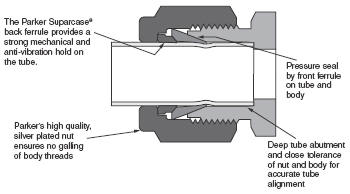 two-ferrule pairs can usually be swapped with the single-ferrules, except that
doing so may require an extra fractional turn on the nut to sufficiently tighten
it down on the tube. The inside tops of the nuts are sometimes designed
with slightly
different angle for single, vice two-ferrule, applications.
Single-ferrule nuts have a flatter surface, whereas two-ferrule
nuts have a more-slanted contact surface. Look closely at the nut cut-away
picture on the left.
two-ferrule pairs can usually be swapped with the single-ferrules, except that
doing so may require an extra fractional turn on the nut to sufficiently tighten
it down on the tube. The inside tops of the nuts are sometimes designed
with slightly
different angle for single, vice two-ferrule, applications.
Single-ferrule nuts have a flatter surface, whereas two-ferrule
nuts have a more-slanted contact surface. Look closely at the nut cut-away
picture on the left.
Two-ferrule connections are preferred over the single-ferrule connections since they require less torque to tighten to specifications. In a two-ferrule design, the back-ferrule (contacts the nut) is designed to rotate somewhat with the nut instead of the lower ferrule which gets swaged on. This helps reduce torque and twisting action on the tube and/or lower ferrule that actually does the sealing. SwageLok and other manufacturers try to reduce the friction between the nut and back ferrule, and SS-on-SS galling, by coating the inside of the nuts with "silver." It looks like a white/matte-silver finish if you look closely. My ultrasonic cleaner (set on highest power) actually stripped off some of this silver coating from the nuts before I learned what it was and its purpose.
Several sets of ferrules were sacrificed during the plumbing of this project, so it is recommended that you locate a local store to get extras if/when needed in a hurry. The two-piece sets average about $1.50 each MSRP.
Where to buy fittings
Those who have the luxury (and patience) of time to watch eBay and plan as you
go along, will be rewarded. I bought most everything I needed over a
period of 4 months from eBay, even though I kept buying additional fittings as
plans changed and I starting putting things together. eBay offers the
chance to buy brand-new fittings at less than half the customary MSRP, and
sometimes selling as low as 5-10%. eBay stores, which carry a constant
selection of wares will often sell their new stock at about 60-80% of MSRP at
worst. Optionally, there are usually some local stores (plumbing
supply) suppliers that stock or can order fittings for you. This may be
cost-efficient for lower-value items like 1/4 tube to 1/4" MNPT fittings,
since they are already fairly cheap.
Strategy for selecting fittings
When buying parts on eBay, sometimes just getting a needed part is more
important (due to price/availability) then the gender it comes in. For
instance, the only appropriate SS high-pressure (HP) ball-valves I could find
over a 3-month period on eBay had 1/4" tubing connectors, and not NPT as I
originally had planned for. I decided I could still come out ahead on cost
by just getting adapters for
them. To compound matters further, two of the ball-valves I bought came
with 3/8 tubing connections instead of 1/4 like the others. But the price
still made it worth acquiring additional 1/4" reducer couplings for them, and I
didn't know if I'd ever come across some of these in the near-future again.
There is a balance of design issues, cost, and effort that you must decide on for yourself when making up your own design. When a single item costs $15-$30, sometimes the added cost of gender conversions (another $10 + shipping) are not as significant, but not always! Remember that adding a gender conversion also introduces additional potential leakage point(s) so are to be avoided if possible. Sometimes the cost of adding a gender conversion is more than the original part is worth in the preferred gender, and you are better off waiting for the desired part to show up for sale on eBay
As far as MSRP pricing goes, an equivalent female connection is ~20-30% more costly compared its male version, especially with NPT fittings. This is due in part to extra metal required for them and additional complications in machining them. Tee fittings are very expensive in most cases since their shape dictates that the metal be cast during manufacturing instead of just machining. You may be surprised to see the MSRP prices almost six times as much for a tee as the straight version of any given connector! Cross (4-way) versions are very expensive.
Also be careful when deciding on your highest bid prices on auctions: the average $5-$10 shipping cost per auction can really degrade the savings of what you're buying if it's the quantity is in small amounts (1-5 items) or not worth >$15
NPT gender considerations
If you're not sure of your plumbing plan and all the gender conversions you may have to make after purchasing NPT fittings, try to favor buying the female NPT (FNPT) genders instead of the male versions (MNPT). The usual mark-down on the female versions is far more than their male versions on eBay. Most of the fittings on eBay always always seem to be in the opposite gender of what you're looking for, toeing the line with Murphy's Law. FNPT fittings are not as common as their male counterparts it seems. But when needed, nipples are cheaper to adapt FNPT firttings than couplings are to adapt MNPT fittings. Check out SwageLok's NPT fittings catalog for good information on commonly-available configurations and how to use NPT fittings.
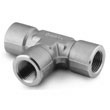



For fittings with NPT connections, you may have to buy SS MNPT
hex nipples (~$4
MSRP) and/or SS FNPT
hex couplings (~$6 MSRP) to reverse the NPT gender. I was
lucky in that I only needed two couplings for my project, and I could have
eliminated each of those and their extra
MNPT->tube fittings if I only had a
FNPT -> tube adapter to begin with. However, I already had the
MNPT fittings,
and the cost of the
coupling was less than the
optimal adapter, so I tried to
use up what I had on hand when I could. You will often find that you end up with
more fittings of one type than you really need when buying lots from eBay. Just
resell them when you're finished with your project.
Here's a sampling of fittings (or their equivalents) that I used. MSRP's are from
a local SwageLok dealer. Additionally I listed what I paid (including
shipping) for the parts on eBay auctions. Some of my winnings were not
really a great deal in cost, and some were an absolute steal. I only list
these for real-life examples of what these items can go for.
 |
SS 1/4" FNPT tee MSRP $19.80 A large lot of the Parker-brand tees were secured on eBay for $7 each |
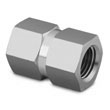 |
SS 1/4" FNPT coupling MSRP $8.20 These were $6 at the local hose and rubber shop |
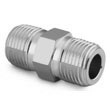 |
SS 1/4" MNPT
nipple MSRP $4
|
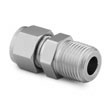 |
SS 1/4" MNPT
- 1/4" tube MSRP $6. eBay: 25 for $95 and 10 for $44. These can go for $2-4 each and show up for auction quite often |
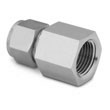 |
S 1/4" FNPT - 1/4" tube
MSRP $9.80. eBay: 12 for $84. Ideally, you could use these on all the CGA nipples like those on the lowest-pressure bank, as long as you can secure the required tube tees cheaply |
 |
SS 1/4" tube tee MSRP $19. eBay 9 for $58. These auction between $4-10 each |
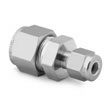 |
SS 1/4" 3/8 reducing union 1/4 MSRP $13.30 eBay: 5 for $10. Sometimes these go for next to nothing since most people have no use for them. |
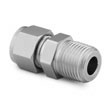 |
SS 1/4" MNPT
3/8" tube MSRP: $8.30 eBay: inclusive in a large mixed-bag lot of miscellaneous fittings. The average cost probably came out to about $3 each |
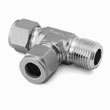 |
SS 1/4" tube male run tee MNPT MSRP $23.40 eBay: also in a large mixed-bag lot. Estimated price: $4 each |
 |
SS 1/4" tube ferrule sets MSRP $1.60 |
|
|
SS 1/4" tube ferrule set & nut MSRP $3.22 Nuts can usually be salvaged |
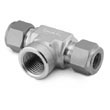 |
SS 1/4" female branch tee MSRP $27.40 None of these ever showed up on eBay, but would have been the optimal fitting for the ends of the NPT CGA nipples.. |
Sometimes the price of fittings as well as timeliness of finding what you need in a hurry dictates what you end up buying. Due to an immediate need for 1/4" MNPT -> 1/4 tube connectors, I bought the following elbows instead of the straight versions. These elbows actually ended up being more useful in some places for the finished design.
 |
Ham-Let 769L SS 1/4 X 1/4 MSRP ? eBay: 8 for $13.50. These came as single-ferrule units instead of the more-common double-ferrule. |
Manifold fittings
To connect my air and mix manifolds end-to-end, the following fittings were used,
even though it requires some faith in their conservative (3900 PSI) pressure rating! A 10%
over-pressure rating would result in 4200PSI, so it's not too far from the target
pressure I wanted at 4500 PSI
 |
PRECISION THRD HI-PRESSURE BRASS PIPE FITTING, 1/2" X 1/2" PIPE SZ,HEX NIPPLE,3900 PSI $5.14 |
At the ends of each manifold, the following fitting was to convert back to a 1/4" female NPT gender:
 |
PRECISION THRD HI-PRESSURE BRASS PIPE FITTING, 1/2"MALE X 1/4"FEM PIPE SZ, HEX BUSHING, 3900 PSI $4.38 |
Quick-disconnects
Since the Oxyhacker's
Companion book turned me on to to these particular quick-disconnect (QD)
fittings, I have bought a lot of brass Parker
ST-series QD's from McMaster-Carr and used them for nearly every non-permanent
connection I have for my fill-station equipment. I
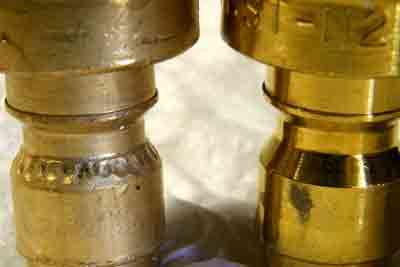 also found imitations at a local
hose & rubber shop that were cheaper, but not as smooth-acting, and not as well-made as
the Parkers. For the price difference, the genuine Parkers are the way to go. These
QDs are brass, and rated to 5,000 PSI, which is unusually high for brass
fittings. I have used these
fittings at 5,000 PSI several times and the steel ball-bearings in the female
socket will indent themselves into the brass male part, as shown on the left
fitting in the picture. This happens to a very small extent at 3,000 PSI.
I don't not believe the integrity is compromised much from this, but the
zinc-plated steel versions of these nipples may be preferable in non-O2
environments at high pressures instead. However, the bearings even dimpled
the steel nipples too, but not as bad as the brass ones shown here.
also found imitations at a local
hose & rubber shop that were cheaper, but not as smooth-acting, and not as well-made as
the Parkers. For the price difference, the genuine Parkers are the way to go. These
QDs are brass, and rated to 5,000 PSI, which is unusually high for brass
fittings. I have used these
fittings at 5,000 PSI several times and the steel ball-bearings in the female
socket will indent themselves into the brass male part, as shown on the left
fitting in the picture. This happens to a very small extent at 3,000 PSI.
I don't not believe the integrity is compromised much from this, but the
zinc-plated steel versions of these nipples may be preferable in non-O2
environments at high pressures instead. However, the bearings even dimpled
the steel nipples too, but not as bad as the brass ones shown here.
I've had o-rings in the female QD's leak some, but it's mainly from putting a lot of stress on the connection where the o-ring gap between male tip and female body opens too wide for a worn o-ring so seal. But this is more the exception than the rule.
I use male QDs on my hoses and female QD's on other
parts; fill whip ends, Haskel inlets/outlets, manifolds, gauges, etc. I
always replace the o-rings (size 110) in them with O2-cleaned EPDM or Viton, for
good measure.
 |
Parker BST-N2 1/4" MNPT $2.09 |
 |
1/4" FNPT $2.15 |
 |
Parker BST-2M 1/4" MNPT $4.41 |
 |
1/4" FNPT $4.30 |
.
These QD's come packed with silicone(?) grease. I take them
apart and toss them in the ultrasonic cleaner for a bath like every other
fitting I use. Afterwards, putting the ball bearings back into the female couplings can be
tedious. I sometimes roll the bearings in Christo-lube or other
oxygen-compatible grease just to make them "sticky" enough stay in their
sockets until the locking-sleeve can be put in place.
GO TO PAGE:
1 - Introduction 2 - Bank Bottles 4 - Tubing 5 - Valves 6 - Manifolds, whips, gauges,O2-cleaning 7 - Results & Pictures